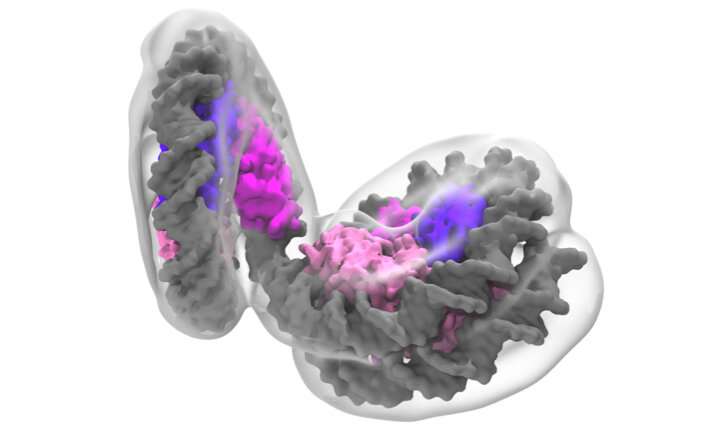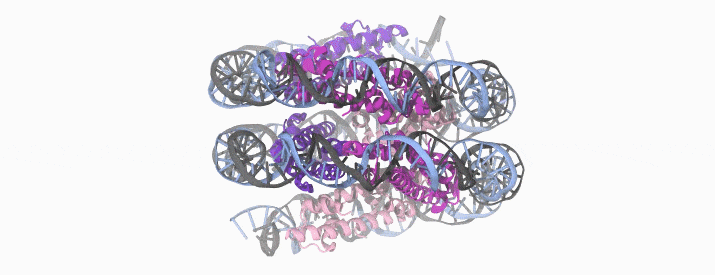Archaeal DNA forms coils that can flop apart in solution, new cryo-electron microscopy experiments reveal. Credit: S. Bowerman et al./eLife 2021
New cryo-electron microscopy images suggest archaeal microbes pack their chromatin into tight coils that can spring open, forming unexpected contortions.
In some single-celled organisms, DNA coils like a spring and opens like a book.
Microbes called archaea package their genetic material into flexible shapes that flop open in unusual ways, Howard Hughes Medical Institute (HHMI) Investigator Karolin Luger reports March 2, 2021, in the journal eLife. "Very much to our surprise, we found that these structures can undergo all sorts of gymnastics," says Luger, a biochemist at the University of Colorado Boulder.
Like DNA in the nucleus of human cells, archaeal DNA coils around proteins like string wrapped around a yo-yo. But there's another twist, the team found. Those coils of DNA can also spread 90 degrees apart—a phenomenon scientists hadn't seen before. Such bends in the springlike structures could potentially let archaeal proteins sidle up to the DNA and switch genes on and off, Luger suggests. (Scientists don't currently understand what role these "slinkies" play, she says.)
It's unknown whether DNA in other life forms undergoes similar contortions, says molecular biologist Steve Henikoff, an HHMI Investigator at the Fred Hutchinson Cancer Research Center who was not involved with the new work. But, he says, the team's work "certainly makes a compelling case for a new and interesting mode of gaining access to the DNA."
Credit: Howard Hughes Medical Institute
Along with Eukarya and Bacteria, Archaea are one of the three domains of life. These microbes are survivors—they live in all sorts of extreme environments, including deep-sea hydrothermal vents hot enough to boil water and briny lakes saturated with salt. But scientists are learning that archaea are more widespread, too. "You can literally go out and scrape some up in the dirt from a sidewalk crack," Luger says.
In 2017, Luger's team discovered that archaea bend their DNA in a way that's nearly identical to how humans and other complex organisms do it. People, plants, animals, and fungi all coil DNA around proteins called histones. It's a packing trick that helps cells cram long lengths of DNA—as much as two meters in humans—into the nucleus.
The team's finding hinted that genome packing may have originated in archaea, organisms that lack nuclei. Archaeal DNA and protein formed telltale Slinky-like coils, crystal structure experiments revealed. But crystal structures capture just a snapshot in time, in an unnatural environment, says study lead author Sam Bowerman, also at the University of Colorado Boulder. "The question was, do these slinkies actually exist in solution? Do they stretch and bend?"
Computer simulations of archaeal DNA (gray and blue) wound around proteins (pink and purple) suggest that the coiled structure is flexible. Credit: S. Bowerman et al./eLife 2021
The team set out to see how archaeal DNA behaved in an environment more like the inside of a cell. Computer simulations suggested that the DNA coils could spread apart a bit, but "we assumed they would just form super long, uninterrupted slinkies," Bowerman says.
State-of-the-art cryo-EM, a type of electron microscopy, let the researchers examine archaeal DNA in different solutions. Those experiments were originally intended to be a training project for Bowerman, a physicist, to learn biochemistry and structural biology, Luger says. But as soon as they saw the results, "we knew we were onto something unexpected and weird," she says.
In some cases, the DNA coiled just as expected. In others, the coils contorted dramatically, unhinging and open up like a clamshell. Bending the DNA slinky in this way might expose particular archaeal genes, which the cell could then turn off or on. It would be a stark contrast to what happens in complex organisms, which instead use specialized proteins to unpack genomic DNA and gain access to specific genes.
Bowerman notes that the idea still needs to be confirmed in studies of archaeal cells, rather than DNA in solution. The team also wants to find out how common a phenomenon these bendable DNA slinkies really are. Studying strange organisms like archaea can help scientists answer questions about multicellular life, Luger says. "For gaining fundamental knowledge, sometimes it's important to peek across the fence and see what the neighbors are doing."
More information: Samuel Bowerman et al. Archaeal chromatin 'slinkies' are inherently dynamic complexes with deflected DNA wrapping pathways, eLife (2021). DOI: 10.7554/eLife.65587
Journal information: eLife
Provided by Howard Hughes Medical Institute

























